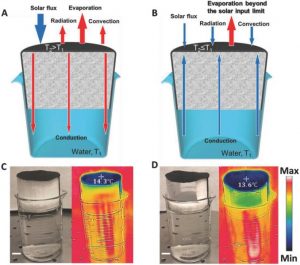The dream of energy-harvesting and conversion technologies, such as thermal steam generation or cold solar vapor, is to achieve 100% efficiency. This ideal has yet to be attained; though, research continues towards this goal.
Steam has been used in steam engines for eons, from the first rudimentary devices in ancient Egypt to the first commercially successful steam powered device at the dawn of the industrial revolution, and to current day desalination technologies.
In seawater desalination, thermal steam generation and condensation was one of the dominant technologies before the introduction and ultimate take-over of reverse osmosis. However, a growing concern of the environmental impacts of the latter have lead researchers and industry to look towards alternatives.
Conventional techniques for the generation of solar vapor only achieve efficiency of 30 to 40%, and are generally costly, due to the cumbersome and expensive optical concentration systems that must be employed. Moreover, recent research into metallic plasmonic and carbon-based nanomaterials has yielded efficiencies that still do not meet the dream goal of 100%.
Lead by Dr. Qiaoqiang Gan from group at University at Buffalo with co-workers at the University at Buffalo, the University at Wisconsin Madison and Fudan University (China) research into cold vapor generation achieved efficiencies beyond the solar energy limit.

Physical mechanism of vapor generation.
The manuscript, dedicated to the memory of Dr. Suhua Jiang (1976–2017), explores the use of solar energy to generate cold vapor below room temperature. This approach enables efficient solar vapor generation with efficiency reaching to approximately 100%–the holy grail of energy-harvesting and conversion technologies.
To achieve this “holy grail” efficiency, one must understand that the surface temperature of a natural evaporator is lower than the temperature of the surroundings since water vaporization requires energy. When weak incident light is introduced such that the temperature of the system is increased slightly, but remains lower than the surroundings, the absorbed light energy will not be lost to the adjacent warmer environment. This results in near 100% absorbed-light-to-vapor energy conversion efficiency.
Specifically, if the operation temperature of the system is below that of the surroundings, the total vapor generation rate is higher than the upper limit that can be produced by the input solar energy, due to the extra energy contribution from the environment.
Dr. Gan’s team designed a practical and low-cost architecture for the solar vapor generator, and provided experimental validation to demonstrate this intriguing strategy. The best measured total vapor generation rate was ≈2.2 kg m-2 h-1 under 1 sun illumination, well beyond its corresponding upper limit of 1.68 kg m-2 h-1.
This novel research direction to explore and develop different evaporative materials provides a path towards applications in solar still technology, evaporative cooling, humidification, and even in water-evaporation-induced power and electricity.
In addition, cold vapor generation will raise new scientific discourse on moisture condensation for water collection, especially in passive systems without electrical power. Thus, the integration of this evaporative regime with emerging day-time radiative cooling systems will initiate a revolution in thermodynamic technologies.
Written by Jodie Haigh in coordination with the researchers.

















